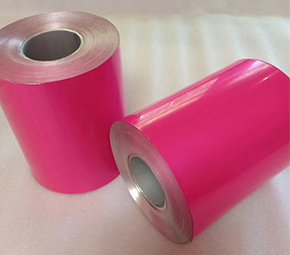The double-zero aluminum foil tackiness phenomenon includes two layers of meaning: the mechanical properties of the aluminum foil are not suitable for use and the degreasing effect of the aluminum foil surface is poor, which causes the aluminum foil to be peeled off during use. By improving the finished annealing process and controlling the rolling oil volume and its physical and chemical properties in the rolling process, the parameters of the tension of the slitting and slitting are adjusted to eliminate the stickiness defect of the aluminum foil. Aluminum foil is soft and hard according to the production state. Most of the double-zero foil is used after softening annealing. The softening annealing is not only to control the mechanical properties of the aluminum foil, but also to eliminate the residual oil on the surface of the aluminum foil, to obtain a smooth and bright surface, and to Free to expand. Aluminum foil for different purposes, the required degree of degreasing is different, such as aluminum foil for composite use and aluminum foil for capacitors. However, in recent years, users have become more and more demanding on the quality of double zero foil. Aluminum foil sticking becomes one of the main defects. The soft state double-zero foil sticking phenomenon is mainly manifested as: the double-zero foil feel is “soft”, and it is not easy to maintain a flat plate shape during the user's use; double zero foil roll layer and layer Inter-adhesion, severe formation of "knot", in the process of unwinding, the peeling is difficult, resulting in aluminum foil can not be used normally. Seriously affected the production and sales of aluminum foil.
Rolling process control
Through proper annealing process, good degreasing effect can be achieved, and high-quality aluminum foil with clean surface, no residual oil, no adhesion, no oil spots and smooth unwinding can be obtained. However, there is a premise here that the aluminum foil with the amount of oil in the rolling process and the properties, types and ratios of the rolling oil and additives must be suitable. If the rolling process has a large amount of oil, a good degreasing effect cannot be achieved by the subsequent annealing process.
1. Control of rolling oil volume The surface residual oil thickness of double zero aluminum foil in hard state is about 0.02~0.2μm. The large amount of residual oil on the surface makes it difficult to refine and process aluminum foil. In actual production, the oil content on the surface of the aluminum foil on the exit side of the rolling mill should be closely monitored. No visible white oil traces are allowed. Otherwise, the support roller cleaning roller and the outlet oil-proof plate cleaning roller and the rolling should be inspected and adjusted in time. Line parameters, etc.
2. Control of rolling speed The rolling speed is too fast, the oil film on the surface of the aluminum foil will be thickened, the oil content caused by the splashing will also increase, and the surface gloss of the aluminum foil will become dark, which will cause difficulties in the annealing and degreasing process. The finishing speed of the finished product of double zero foil is not easy to exceed 500m/min, and the pass reduction rate is also controlled at about 50%.
3. Physical and chemical properties of rolling oil and additives In addition to cooling and lubrication, aluminum foil rolling oil should also ensure that the surface of aluminum foil is bright, volatile during annealing, rolling reaches a certain reduction ratio, oxidation stability is good, and it is not difficult. Smell the smell and so on. Rolling oil is generally based on mineral oil, viscosity (1.5 ~ 3.0) × 10-6m2 / s, additives are higher fatty acids, higher fats and higher alcohols. The acid molecule has strong polarity and forms a relatively strong adsorption film on the surface of the aluminum foil. At a higher annealing temperature, decomposition and oxidation of the oil film carbon chain occurs, causing aluminum foil contamination and causing yellowish brown oil spots. Since the minimum concentration of oleic acid saturated adsorption is 1%, a small amount of oleic acid can be formed on the surface of the aluminum foil by adding a small amount of oleic acid to the rolling oil. Moreover, oleic acid belongs to an unsaturated molecular structure and is used in a long-term process. In the middle, oxidative deterioration is easy to occur, so it is not desirable to use it in large quantities. The control of the rolling oil temperature is very important. As the rolling oil temperature increases, the rolling oil may become poorly lubricated, the rolling load will increase rapidly, the rolling speed will increase, the rolling mill oil will be severe, and the aluminum sticking phenomenon will increase. When using fatty acids, fine powders are formed faster than alcohols or fats, and based on this, excessive use of oleic acid should also be limited.
Slitting process control
The degreasing quality of the surface of the aluminum foil is related to the quality control of the rolling process and the annealing process, and also related to the degree of tightening of the slitting process. Since the aluminum foil coil is surrounded by hot air in the annealing furnace, the rolling oil between the foil layer and the layer needs to escape through a certain gap, and volatilizes into a gas, such as the aluminum foil coil is too tight, and the rolling oil is volatilized. It becomes difficult. In production, it is important to control the void ratio of the double zero foil. In the slitting operation, according to different material widths, the taper tension of the slit is adjusted between 6% and 32%, and a good degreasing effect is obtained.



.jpg)


